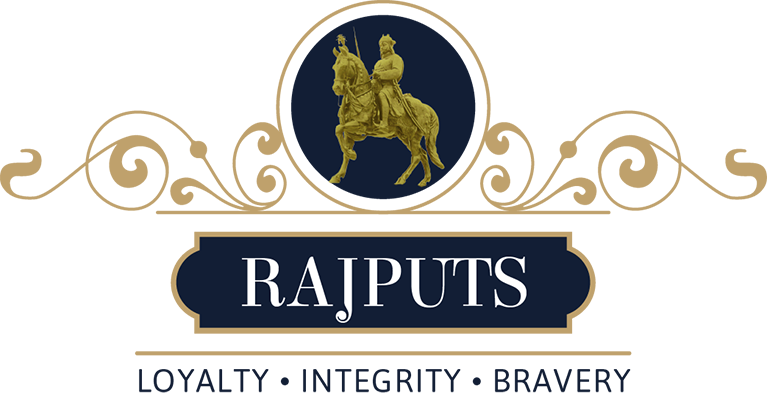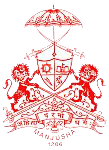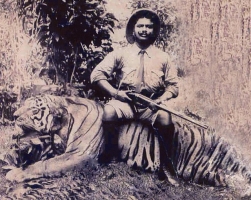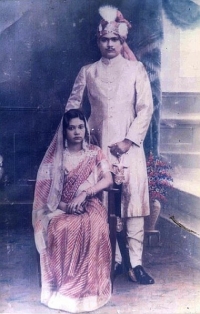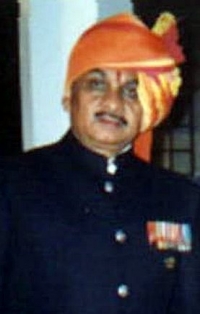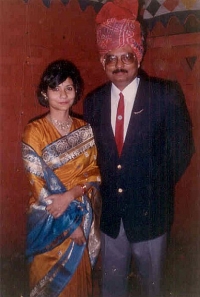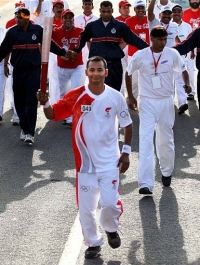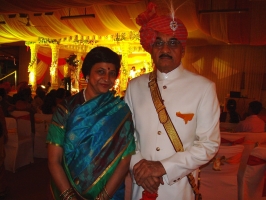Present Head
Col. (Ret'd.) Meherban-i-Dostan Raja CHHATRAPATI SINGH Deo, present and 51st Raja Saheb of Mandasa (Manjusha) since the 26th January 1976. (Manjusha House, 33-17/2, Officers Colony, P.O. Ramkrishnapurram, Secunderabad 550056, A.P., India) born , educated at La Martiniere College, and at St. Xaviers College Calcutta, A.D.C. to the President of India, served with distinction in the Indian Army, as a Captain in 7th Light Cavalry, he participated actively in the India Pakistan War of 1971, which saw the birth of Bangladesh, he is responsible for the greening of Mussoorie Hills as Commanding Officer of the Ecological Battalion of Territorial Army at Dehra Dun and is a recipient of the Indira Gandhi Pariavaran Award; Secretary General of the Rowing Federation of India, International Rowing Umpire, Vice President Asian Rowing Federation, elected as President of he Rowing Federation of India for 2008 to 2012, Executive Committee Member Indian Olympic Association, Deputy Chef-de-Mission Busan Asian Games, member Secunderabad Club, member Bhubaneswar Club Ltd; the Centenary Celebrations of the Srinivasa Raja Mani Zilla Parishad High School, were held in the year 2005. Raja Chatrapati Singh Deo and Rani Rajlaxmi Singh Deo graced the function as Honoured Guests, which was also attended by many prominent personalities, including past students, who are now well settled in India and abroad. The School, was set up by the Manjusha Royal Family during the reign of Raja Vasudev Rajamani Raj Deo, in the year 1905 and handed over to the Government after the abolition of the Zamindari System. On the occasion, two statues, one of Capt. Raja Sreenivasa Rajamani Raj Deo and another of Lt. Raja Jaganath Rajmani Raj Deo were installed in the school premises; he is also the Hereditary trustee of the Temple of Lord Jagananth, which is within the Palace compound. The building had become old and dilapidated and with the initiative of Raja Chatrapati Singh Deo and the cooperation of the well wishers, namely the people of Manjusha, a brand new Temple has been constructed and has become an important landmark; he married Rani Rajlaxmi Singh Deo, only daughter of Raja Rabindra Narayan Bhanj Deo of Kanika, and has issue, two sons.
- Yuvraj Akshay Pratap Singh Deo, born , MBA from Xavier's Institute of Business Management, Bhubaneswar, presently working for a Multi National Company at Singapore.
- Rajkumar Vishal Pratap Singh Deo, born , Graduate and working for Max New York Life Insurance at Hyderabad.
History
The past glory of Manjusha, which had a very important place in the Kalinga era, is evident even today, through oriya books and documents available with libraries and individuals. Also known as Mandasa, it is a very old princely house, the first Raja of Manjusha being, Raja Vaman Singh Deo, a Rajput from the North, who established the Kingdom in 1206 A.D. It is said that he gave up his kingdom to his uncle in the North of India and came to the Mahendra Hills for penance and established the kingdom of Manjusha thereafter. Legend has it that while doing penance, he had a vision that his Kingdom would be established at a place where a sign from him would be found. At that moment a gold ring slipped from his finger and fell into the river. It was found downstream at a certain place and the Kingdom of Manjusha was established there. The river still flows and its name is very apt, "Suna Muddi" [Golden Ring]. The head of the family continues to bear the the hereditary title of Raja. Manjusha was initially in Ganjam District of Madras Presidency then it became part of Vizag Distirct of Madras Presidency, when Orissa was formed in 1936 and is now in Srikakulam District of Andhra Pradesh. It can be approached from the NH-5 between Sompeta and Palasa. While there is a Railway Station, Mandasa Road, for important trains the Railway Station is Palasa about 11 km away . It is a place of scenic beauty with the Mahendra Giri Hills of the Eastern Ghats in the West and the Bay of Bengal in the East. The Manjusha (Mandasa Zamindari) is surrounded by the Bay of Bengal in the east, Tarla and Parlakhimidi Zamindaris in the South, the Mahendra Giri Hills in the West and Jalantara and Budharsingi Zamindaris in the North. Two rivers , namely the Sunnamuddi and the Mahendra Tanaya flow from the Mahendra Giri mountains and fall into the Bay of Bengal. Lord Vasudev is the presiding deity of Manjusha, while Ma Khillamonda is worshipped as the presiding Devi. Manjusha is also noted for the Manjusha Library, which is more than 115 years old, and was earlier the personal Library of the Raja Jaganath Rajamni Raj Deo I of Manjusha. Nowadays, it is managed by a Trust, and is perhaps the oldest Oriya Library in the world. Manjusha is a place of religious and mythological importance. It is said that the Pandavas, in the course of their wanderings stayed for sometime in the Mahendra Giri Hills. There are Temples dedicated to the Pandavas as well as a Shiv Temple. On the day of Shivaratri, a big festival is held which attracts thousands of pilgrims to the Hill top. The Raja Saheb of Manjusha is the Hereditary Trustee of these Temples. It is also recorded in Indian Mythology that Hanuman jumped from the Mahendra Giri Peak to Lanka, in search of Devi Sita. Mahendra Giri is also supposed to be the abode of the ancient Sage Parsurama. Lord Vasudev is the presiding deity of Manjusha, while Ma Khillamonda is worshipped as the presiding Devi. Manjusha is also noted for the Manjusha Library, which is more than 115 years old, and was earlier the personal Library of the Raja Jaganath Rajamni Raj Deo I of Manjusha. Nowadays, it is managed by a Trust, and is perhaps the oldest Oriya Library in the world.
Genealogy
- Raja PANCHANAN VAMAN SINGH Deo, 1st Raja of Manjusha 1208/1227,he was the first Raja of Manjusha, he originally had his kingdom somewhere in the North of India - Panchala (modern day Punjab). He was a Chandra Vanshi Rajput, who gave up his kingdom to his uncle and came to do penance and worship Lord Gokuneswara in the Mahendra Giri mountains in 1206AD.
- Raja MADHUSUDAN SINGH Deo, Raja of Manjusha 1227/1238
- Raja GOPINATH SINGH Deo, Raja of Manjusha 1238/1253
- Raja NIRANJAN SINGH Deo, Raja of Manjusha 1253/1265
- Raja YOGENDRANATH SINGH Deo, Raja of Manjusha 1265/1276
- Raja MAHIMAD SINGH Deo, Raja of Manjusha 1276/1286
- Raja NILAMBAR SINGH Deo, Raja of Manjusha 1286/1294
- Raja SADASHIV SINGH Deo, Raja of Manjusha 1294/1302
- Raja NILAKANTH SINGH Deo, Raja of Manjusha 1302/1317
- Raja MUKUND SINGH Deo, Raja of Manjusha 1317/1334
- Raja AMAR SINGH Deo, Raja of Manjusha 1334/1355
- Raja NARASINGH SINGH Deo, Raja of Manjusha 1355/1360
- Raja MRUTANJAY SINGH Deo, Raja of Manjusha 1360/1375
- Raja GAUR CHANDRA SINGH Deo, Raja of Manjusha 1375/1389
- Raja ANANG SINGH Deo, Raja of Manjusha 1389/1401
- Raja VIJAY SINGH Deo, Raja of Manjusha 1401/1404
- Raja PARASHURAM SINGH Deo I, Raja of Manjusha 1404/1421
- Raja JANARDAN SINGH Deo, Raja of Manjusha 1421/1430
- Raja VISHAMBAR SINGH Deo, Raja of Manjusha 1430/1457
- Raja GOPAL SINGH Deo, Raja of Manjusha 1457/1476
- Raja GOVIND SINGH Deo, Raja of Manjusha 1476/1490
- Raja HARI SINGH Deo, Raja of Manjusha 1490/1505
- Raja SHIV SINGH Deo, Raja of Manjusha 1505/1511
- Raja VENKATESH SINGH Deo, Raja of Manjusha 1511/1515
- Raja KURMA SINGH Deo, Raja of Manjusha 1515/1542
- Raja SHRIRAM SINGH Deo, Raja of Manjusha 1542/1565
- Raja MAHAKAL SINGH Deo, Raja of Manjusha 1565/1596
- Raja RAMCHANDRA SINGH Deo, Raja of Manjusha 1596/1609
- Raja SHRIDAR SINGH Deo, Raja of Manjusha 1609/1611
- Raja PARASHURAM SINGH Deo II, Raja of Manjusha 1611/1620
- Raja VANMALI SINGH Deo, Raja of Manjusha 1620/1625
- Raja KRISHNA CHANDRA SINGH Deo, Raja of Manjusha 1625/1636
- Raja MUKUND SINGH Deo, Raja of Manjusha 1636/1646
- Raja GOVIND SINGH Deo, Raja of Manjusha 1646/1662
- Raja JAI SINGH Deo, Raja of Manjusha 1662/1673
- Raja PITAMBER SINGH Deo, Raja of Manjusha 1673/1676
- Raja VENKATESHWAR SINGH Deo, Raja of Manjusha 1676/1683
- Raja BANDI SINGH Deo, 38th Raja of Manjusha 1683/1696, Manjusha had a very peaceful existence till the reign of Raja Bandi Singh Deo, who fought many wars with neighbouring kingdoms.
- Raja RAGHURAM CHAMPATI Deo, 39th Raja of Manjusha 1696/1710
- Raja DAMODAR CHAMPATI Deo, 40th Raja of Manjusha 1710/1725, established the present town of Manjusha and built the present Manjusha Palace, Damodarpuram, Agraharan and dug the Damodar Sagar, married and had issue. He died in .
- Raja Ganagadhar Rajmani Deo (qv)
- Raja GANAGADHAR RAJMANI Deo, 41st Raja of Manjusha 1725/1735, he is responsible for the Sankujoda pond near Makarjhola village. He died in .
- Raja RAMCHANDRA RAJMANI Deo, 42nd Raja of Manjusha 1735/1744
- Raja HARIHAR RAJMANI RAJ Deo, 43rd Raja of Manjusha 1744/1761, he built a fort at Gopalpurram and while residing there had the Gopalnagar and Hari Sagar Tanks dug. He was responsible for the construction of the Radhakanta Swami Temple at the old fort.
- Raja HARISHARAN RAJMANI RAJ Deo, 44th Raja of Manjusha 1761/1779, he developed a number of Mango orchards. He fought with the Mohamedans living in Patharkonda fort and captured the same. He was responsible for the construction of the Chandishwar Temple in the Manjusha Fort. He died in .
- Raja LAKSHMAN RAJMANI RAJ Deo, 45th Raja of Manjusha 1779/1823, he was a warrior King and had extended the territories of Manjusha considerably. He constructed the Vasudeva Temple and introduced the system of worshipping the deity for nine days (Brahma Utsav). On the advice of the High Priests, he took to Vaishnavism according to a legend which records that while the Raja used to have a shave, a young Brahmin boy used to hold the mirror and he used to do this very competently. One day he faltered and could not hold the mirror properly. The Raja gave him a slap and he died . After that, it is said that the Raja started hallucinating and always felt the presence of the boy and whenever he looked in the mirror he would see the boy's apparition sitting on his shoulders. This caused him so much worry and agony that he almost became insane. During that time Manjusha also lost some territories to its neighbours. The High priest Venketabarad Acharya was consulted and he advised a particular puja, which was then held and the ritual called Brahma Utsav became a regular affair in Manjusha year after year. The Raja thus got rid of the uncomfortable experience. There are stories that the Brahmin boy would be sighted whenever the Brahma Utsav would be held. There was a perpetual boundary dispute between the kingdoms of Manjusha and Budharsingi. In May 1790, the Raja of Budharsingi attacked and set fire to 16 villages of Manjusha. In retaliation, Raja Lakshman Rajmani attacked Budharsingi in August 1790. The Raja of Budharsingi was seriously injured in the battle and fled to the Mahendra mountains for three years.
- Raja SREENIVASA RAJAMNI RAJ Deo I, 46th Raja of Manjusha 1823/1860, and ruled around the beginning of the 19th century. He was a benevolent King, religious and well meaning and constructed many temples, embankments, tanks etc. for the benefit of his subjects. There are many rock edicts and stone inscriptions around Manjusha, which are his proclamations and which tell of his good work. He came back to stay in the old Fort, which is the present Palace. He developed a mango orchard behind the Palace, which became famous under his grandson for housing tigers. He constructed the Raghunath Math, Balaji Math, Rajagopal Math. He also developed a mango orchard called the Jagannatha Vallabha garden on the banks of the River Sunnamuddi and which is a favourite picnic spot for the inhabitants of Manjusha in modern times and is called "Rakta Chandan Tota". He also built the Garuda Govindaswamy Temple on top of Anand Giri Hill and the Travellers Bunglow at Haripuram Town. He constructed a dam on the river Sunnamudi near Hansrali and created a reservoir. He had a good respect for the scholars in languages and music in his court. He had encouraged the translation of sanskrit books of music, Vedasara Sangraha, Natya Chandrika and other books into Oriya. The Raja Saheb used to recite the Vishnu Sahasranam and had composed many works of prose and poetry. He had translated Amaru Satak, Mitakshara and Bhagvat. He was also the author of Mukta Latavali.
- Raja JAGANNATH RAJMANI RAJ Deo I, 47th Raja of Manjusha 1860/1890, C.I.E., he earned fame as Andhra Bhasa Visharad and Tarka Vedanta Kavi. He used to hold discourses on the Mahabharata. Queen Victoria, who was then the Empress of India, had honoured the Raja with the title of C.I.E. (Companion of the most Eminent Order of the Indian Empire), on 1st January 1877, a rare honour which had not been bestowed previously on any Oriya King before him. It is said that Raja Jagannath Rajamani I was the most enlightened ruler of that region in his time. The Viceroy of India, Lord Dufferin had honoured him with two cannons on 2nd August 1887. He constructed the Narasimha and Durga Temples and established the Manjusha Library. He installed a metallic Dhwajathambha in the Vasudev Temple. He had some areas deforested and converted them into paddy fields. He greatly increased the income of the Zamindari. A bungalow was constructed by him at the foot hills of Mahendra Giri (the tallest peak in the Eastern Ghats) which was a Royal Rest House during trips to Mahendra Giri by the Royal family (only the ruins are there today). He was a great patron of the famous astronomer Pathani Samanta. Raja Jagannath had sent intricate local handirafts along with craftsmen, to an exhibition in London and had presented the handicrafts of Manjusha to the world in this way. These exhibits were greatly appreciated and two gold medals were awarded. He established the first English School of Ganjam District at Manjusha and had instituted the Prince of Wales scholarships for meritorious students. He had also established a Sanskrit school which runs even to this day. It was during his reign that the Clacutta Madras Trunk Road (now NH - 5), the Calcutta Madras Railway Line, Railway stations at Mandasa Road and Summadevi were constructed. The land was donated by him free of cost for the purpose. He had contributed for a Hospital Ward at the Gosha Hospital at Madras, he married and had issue, three sons and three daughters.
- Rajkumar Laxmi Narayan Patta Deo, died vpsp.
- Raja Meherban-i-Dostan Vasudev Rajmani Raj Deo (qv)
- Rajkumar (name unknown), known as Thatraj Saheb.
- Rajkumari (name unknown), married to the Raja of Bodogoda in Ganjam District.
- Rajkumari (name unknown), married to the Raja of Baramba.
- Rajkumari (name unknown), married to the Raja of Parikud.
- Raja Meherban-i-Dostan VASUDEV RAJMANI RAJ Deo, 48th Raja of Manjusha 1890/1914, he constructed the Gopal Sagar reservoir near Manjusha Town, adjacent to the Vasudeva Temple along with a Mandap. He was an expert at taming wild animals like tigers, bears, etc. During his reign, the Telegu language assumed importance in the area. He started the practice of observing the Khillamonda Puja for 16 days every year, in honour of the presiding Devi of Manjusha. He was responsible for the constuction of the Vallabha NarayanTemple at Ratti village, on the sea shore. He introduced the practice of Dolo Utsav there every year on 1st January 1901, the Raja and his mother, the Rajmata contributed to the Queen Victoria Memorial Fund, a sum of 2000Rs and also for a Hospital ward at the Gosha Hospital at Madras. Raja Vasudev Rajamani established the Hostel at the Berhampur College, he had instituted scholarships for meritorious BA students at the Vizianagram College and had also established a Girls school at Manjusha. For his magnanimity and well meaning activities for the people, he was honoured with the title of Meherban-I-Dostan. He was a member of the Ganjam Welfare Board and had proved his mettle. He was a pioneer in the formation of a separate province of Orissa and presided over the Utkal Samilani in its initial years; he married a Princess of Parikud, and had issue, one son.
- Capt. Raja Meherban-i-Dostan Sreenivasa Rajamani Raj Deo II (qv)
- Capt. Raja Meherban-i-Dostan SREENIVASA RAJMANI RAJ Deo II, 49th Raja of Manjusha 1914/1930, a very popular ruler who instigated a lot of gaiety and festivities in Manjusha during his reign, the most prominent of which was the Brahma Utsav, a festival of the presiding deity, Lord Vasudev. He liked wrestling and had the title of Mallavidya Visharada. He also hosted the durbar of the Manjusha Raja in honour of visiting Rajas and Maharajas. The Raja Saheb was a keen shikari and had to his credit 108 Royal Bengal Tigers, for which the people of Manjusha presented their Raja with a revolver, with the title of "Tiger Slayer". His hunting expeditions were talked about in the region and beyond. He had a mango orchard called "Bagho Ghara Tota" which literally meant an orchard which is Tiger's Abode. He had kept some tigers in cages in this orchard. In Manjusha Palace, in the South East corner, there was a cage which used to house a Tiger. There was also a painting in the Manjusha Palace, which showed the Raja Saheb in mock battle with a Tiger. All this added to to the folklore in the region and even to this day, when one talks about the Rajas of Manjusha, they ask about the Raja who used to fight with Tigers. It is said that during his reign, there was a severe drought and many people started migrating to Rangoon in search of work. When the Raja Saheb came to know of it, he immediately ordered the construction of a Palatial Building on the North side of the Manjusha Palace, so that the people could be given work. The Building is called 'Panidwar Medho' (building overlooking a pond) and still stands even to this day. He also presided over the Utkal Samilani and was custodian of the very well known weapon collection of Manjusha, known as Mandasa Armoury, the Raja established a school for teaching the Girijans (Savara Tribes) in their own language. The Srinivasa Rajamani High School, which celebrated its centenary recently, was also set up in 1905, he donated the Hostel Building at the Onslow Institution at Chatrapur. It is named after him as the Srinivas Hostel. He patronized art and culture and recognized many deserving people in these fields; married Rani Ratnamala Devi of Tigiria, died , Regent of Manjusha 1930/1934, during the minority of her adopted son, in this period, a bridge was built over the River Suna Muddi, on the Manjusha - Parlakhimidi Road, which is called Srinivasa Bridge, inmemory of Capt. Raja Srinivasa Rajamani Raj Deo. He died sp 1930 and was succeeded by his adopted son, Raja Jaganath Rajmani Raj Deo, eldest born son of Raja Sudarshan Singh Deo of Tigiria.
- Lt. Raja Meherban-i-Dostan JAGANNATH RAJMANI RAJ Deo II, 50th Raja of Manjusha 1930/1976, born , educated at the Ravenshaw Collegiate School, Cuttack and thereafter at Vishakapatnam and Madras Christian College, Madras; granted ruling pwers in 1939 on attaining his majority, as a ruler he was popular, a great host and a keen shikari. He was the youngest President of the Utkal Samilani at Puri in 1942, he was assisted by his able Dewans. After the abolition of the Zamindari system, he continued to stay at Mandasa and contributed to the development of the region; married to Rani Mani Prabha Devi, third daughter of Maharaja Aditya Pratap Singh Deo of Seraikella, and had issue, three sons and three daughters.
- Rajkumari Manasi Devi, born , married to Kunwar Diwakar Vikram Singh of Athadama, passed away 12th April 2008, and has issue, one son.
- Kuwar Shashank Vikram Singh, born .
- Col. (Ret'd.) Raja Meherban-i-Dostan Chhatrapati Singh Deo (qv)
- Rajkumari Rajosi Devi, born , married Subhas Bose, from Kolkata.
- Lt. Rajkumar Pratap Kesari Singh Deo, (Ret'd. TA Officer), born , retired from a Government of Orissa Undertaking, presently he is a Security Consultant; Member of Bhubaneswar Club Ltd., Member of War Veterans Association, he trained in Karate and Judo, and is a former golfer and cricketer, married Pattayet Rani Suneeta Singh Deo, youngest daughter of Kunwar Lal Chandan Singh of Asothar, U.P., and has issue, one daughter. (314 Kharvellanagar, Unit III, Bhubaneswar 751 00, India)
- Kumari Jema Mayurika Singh Deo, born , educated at St. Joseph's High School, Bhubaneswar and is a graduate from Rama Devi, Women's Autonomous College, she topped the college in Political Science, and has worked for HDFC and then Reliance Mutual Funds and continues now on her own as a Mutual Fund Consultant.
- Rajkumari Rupasi Devi, born , unmarried, runs a school in Bhubaneswar.
- Rajkumar Bikram Kesari Singh Deo M.A. (Political Science ), born , educated at Miss B. Hartley's School and St. Lawrence High School, Calcutta and at BJB College and Utkal University (Vani Vihar), Bhubaneswar, he is a quizmaster of repute, he has been Master of Ceremonies on many occasions, including the IIth Asian Rowing Championships held at Hyderabad in November 2005, and has also given live running commentary for Rowing events through Door Darshan; Presdent of the Rotary Club of Bhubaneswar 2006/2007, durng his term as President, the club received as many as 30 awards in Rotary International District 3260 and he was adjudged the Outstanding President for 2006/2007 and the Rotary Club of Bhubaneswar was adjudged the Outstanding Club; member and past Joint Secretary of Bhubaneswar Club Ltd., Member 41 Club No. 37, Bhubaneswar, past Member and Chairman of Bhubaneswar Mid Town Round Table 93 and Calcutta Alipore Round Table 12, founder President of Kalinga Rifle Club, Bhubaneswar; married 29th June 1980 in Baramba, Rajkumari Jyoti Devi, daughter of the last Raja Saheb of Baramba, Raja Krishna Chandra Deb, and his wife, Rani Jyotsna Devi, daughter of Raja Anup Singh Deo of Khariar, a Past President of the Inner Wheel Club of Bhubaneswar and had been adjudged Best President and Best Secretary in the Inner Wheel Movement. She has been Chairperson of Calcutta Alipore Ladies Circle 3 and Bhubaneswar Mid Town Ladies Circle 12. She was twice the Conference Convenor of Ladies Circle Annual General Meeting, at Calcutta in 1992 and at Bhubaneswar in 1995. She was the National Secretary of Ladies Circle India in 1992. She is also the General Secretary of Orissa Pradesh Mahila Congress and Charter Secretary of the newly formed Rotary Club of Bhubaneswar New Horizon, which has only ladies as members, it has taken up notable projects for the welfare of the community, particularly the downtrodden. She runs a Travel Agency and Guest House at Bhubaneswar; and has issue, two sons. (N-3/382, IRC Village, Nayapalli, Bhubaneswar 751 015, India)
- Kunwar Digvijay Singh Deo, born , educated at Kendriya Vidyalaya, Bhubaneswar and graduated from BJB Autonomous College, Bhubaneswar, where he stood Ist class third in English Honours, Post Graduate from the Indian Institute of Mass Communication New Delhi. Has worked for Star News and Door Darshan. Presently Special Correspondent CNN IBN in New Delhi. He has made a mark as a Sports journalist in the electronic media. For sports coverage, he has travelled to Pakistan for cricket, to Melbourne for the Commonwealth Games, to Doha for the Asian Games, to Kuwait for the Asian Games Bid and has just returned back to India after successfully covering the Olympic games at Beijing for his employers, CNN IBN. He was the only journalist in India and the only person from Orissa, who was invited to run with the Beijing Olympic Torch Relay at New Delhi on 17th April 2008. A very rare honour indeed!
- Kunwar Ranvijay Singh Deo, born , educated at Kendriya Vidyalaya, Bhubaneswar, Graduate in Hotel Management from Chanakya Institute Vishakhapatnam, represented school in Kho Kho at the National level (gold medalist), presently working with Hotel Trident Hilton (Oberoi Group) in Chennai.
- Rajkumari Manasi Devi, born , married to Kunwar Diwakar Vikram Singh of Athadama, passed away 12th April 2008, and has issue, one son.
- Col. (Ret'd.) Raja Meherban-i-Dostan CHHATRAPATI SINGH Deo, 51st Raja Saheb of Mandasa (Manjusha) (see above)
Rani Ratnamala Devi, Regent of Manjusha 1930/1934, COURT OF WARDS 1934/1939
